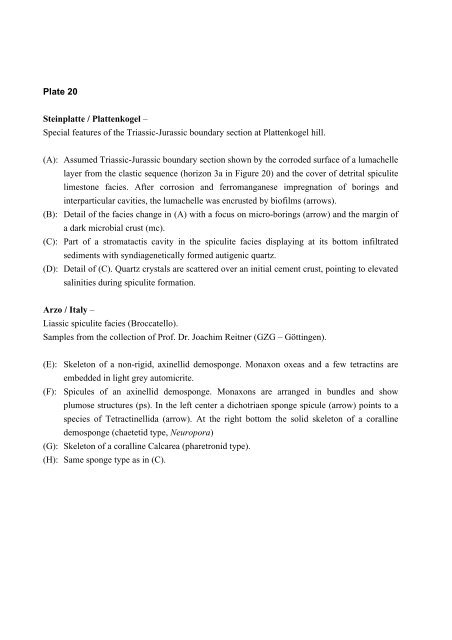Porifera-microbialites of the Lower Liassic (Northern Calcareous ...
Porifera-microbialites of the Lower Liassic (Northern Calcareous ...
Porifera-microbialites of the Lower Liassic (Northern Calcareous ...
Create successful ePaper yourself
Turn your PDF publications into a flip-book with our unique Google optimized e-Paper software.
Plate 20<br />
Steinplatte / Plattenkogel –<br />
Special features <strong>of</strong> <strong>the</strong> Triassic-Jurassic boundary section at Plattenkogel hill.<br />
(A): Assumed Triassic-Jurassic boundary section shown by <strong>the</strong> corroded surface <strong>of</strong> a lumachelle<br />
layer from <strong>the</strong> clastic sequence (horizon 3a in Figure 20) and <strong>the</strong> cover <strong>of</strong> detrital spiculite<br />
limestone facies. After corrosion and ferromanganese impregnation <strong>of</strong> borings and<br />
interparticular cavities, <strong>the</strong> lumachelle was encrusted by bi<strong>of</strong>ilms (arrows).<br />
(B): Detail <strong>of</strong> <strong>the</strong> facies change in (A) with a focus on micro-borings (arrow) and <strong>the</strong> margin <strong>of</strong><br />
a dark microbial crust (mc).<br />
(C): Part <strong>of</strong> a stromatactis cavity in <strong>the</strong> spiculite facies displaying at its bottom infiltrated<br />
sediments with syndiagenetically formed autigenic quartz.<br />
(D): Detail <strong>of</strong> (C). Quartz crystals are scattered over an initial cement crust, pointing to elevated<br />
salinities during spiculite formation.<br />
Arzo / Italy –<br />
<strong>Liassic</strong> spiculite facies (Broccatello).<br />
Samples from <strong>the</strong> collection <strong>of</strong> Pr<strong>of</strong>. Dr. Joachim Reitner (GZG – Göttingen).<br />
(E): Skeleton <strong>of</strong> a non-rigid, axinellid demosponge. Monaxon oxeas and a few tetractins are<br />
embedded in light grey automicrite.<br />
(F): Spicules <strong>of</strong> an axinellid demosponge. Monaxons are arranged in bundles and show<br />
plumose structures (ps). In <strong>the</strong> left center a dichotriaen sponge spicule (arrow) points to a<br />
species <strong>of</strong> Tetractinellida (arrow). At <strong>the</strong> right bottom <strong>the</strong> solid skeleton <strong>of</strong> a coralline<br />
demosponge (chaetetid type, Neuropora)<br />
(G): Skeleton <strong>of</strong> a coralline Calcarea (pharetronid type).<br />
(H): Same sponge type as in (C).

















